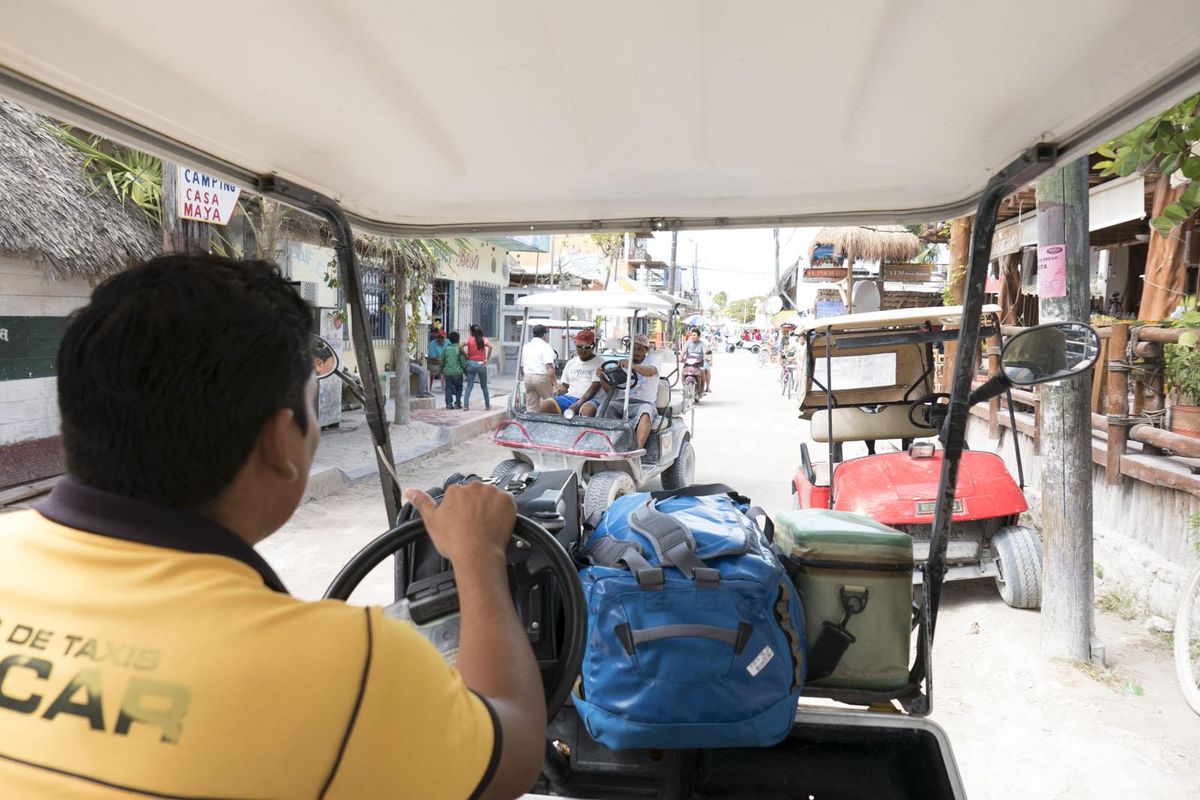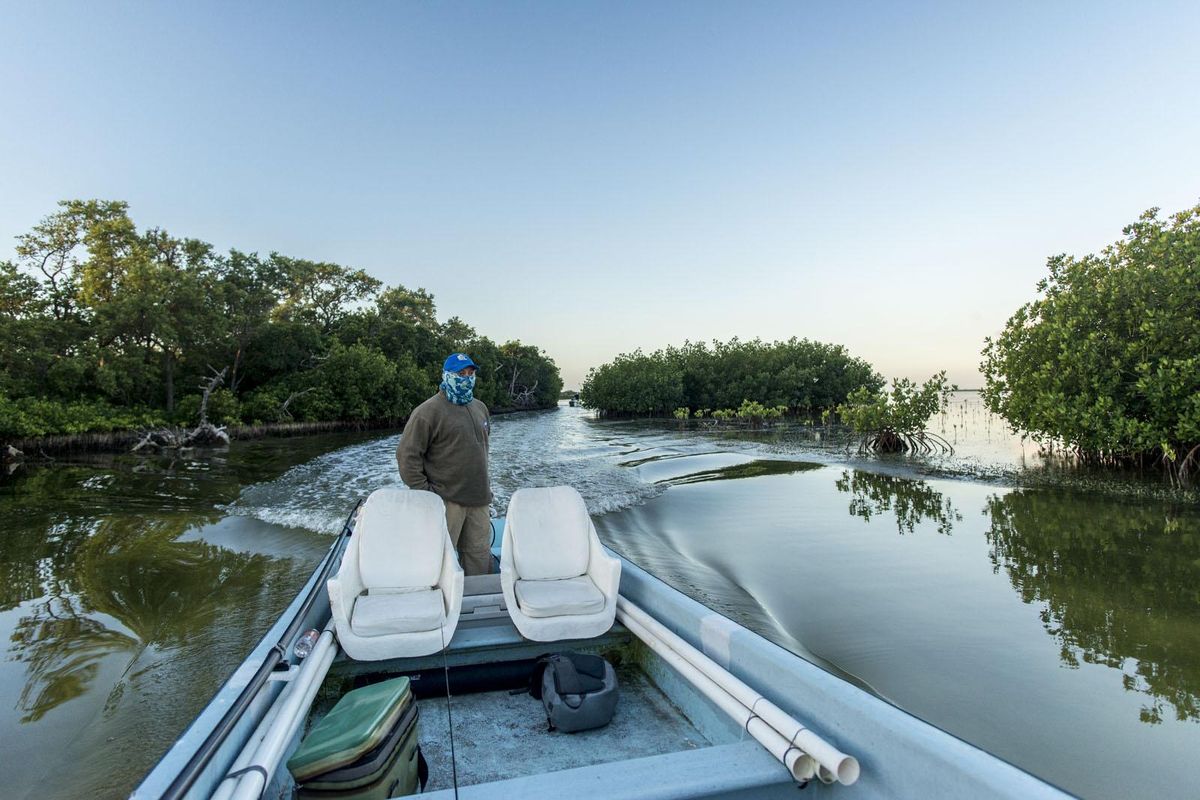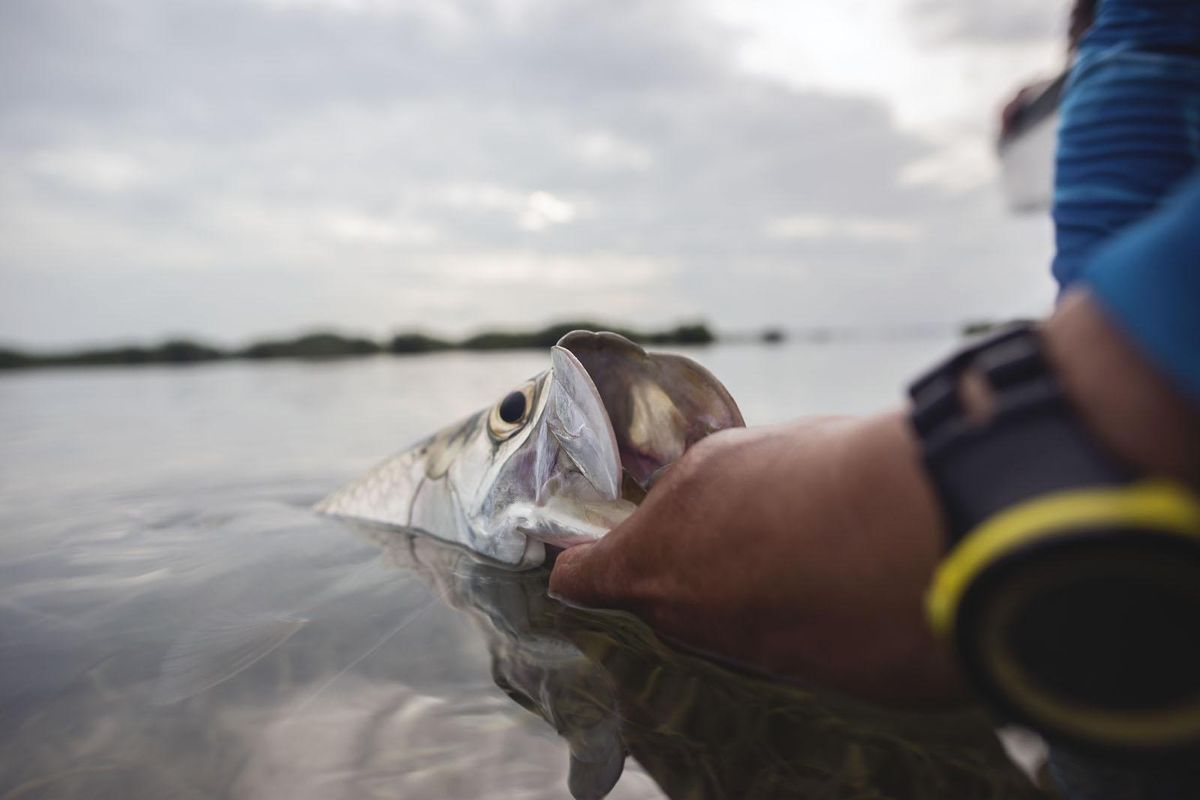Fly fishing guide blissfully humbled by tarpon
Tarpon fishing guide Darwin Vega Cruz motors fly fishers to tarpon water near Mexico’s Isla Holbox, north of Cancun. (Courtesy of Michael Visintainer)
For anglers who have never been saltwater fly fishing for tarpon, I can describe it in one phrase: “A very humbling experience.”
Last month I fulfilled a dream of making the leap from Inland Northwest trout waters to hook up with the legendary species in the fabled saltwaters of Mexico.
I considered myself a fairly proficient angler. I recently finished my master’s program in fisheries science at Eastern Washington University. I guide fishermen for the Silver Bow Fly Shop in the summer and I have fished all over the Pacific Northwest including Alaska and British Columbia.
But standing on the bow of a panga, a deeper-hulled flats boat, casting to my first school of tarpon, I was clearly a minor-leaguer at the plate against the best in the majors.
I completely fell apart. My hands shook. I felt as though my heart was going to beat through my chest, and I initially couldn’t make a cast to tarpon just 30 feet away.
I’ve heard of this happening to other anglers but had never experienced it. Sight fishing to schools of tarpon ranging from 5 to 30 pounds and more will spur most fly fishers into the red zone of excitement.
Standing on the bow of the boat, watching a tarpon turn to chase my fly and then seeing it open its massive mouth to swallow the fly was an experience that might be better described with fireworks than words.
Hooking a tarpon would almost be anticlimactic to the anticipation – except for the bedlam, getting out of the way of the ripping line and listening to the reel scream.
The hookup is like attaching your fly line to a Mack truck and then trying to hold on while it ramps into the air and races around corners.
The baby tarpon I hooked and landed was only 7 pounds, but it was 7 pounds of fury that fought harder than a 15-pound steelhead, the closest resemblance in my fishing repertoire.
The rest of the the saltwater adventure experience in the tropics isn’t bad, either.
Some people enjoy visiting faraway places just to be tourists. The added incentive to fish for species foreign to your home waters is a huge perk.
Catching a tarpon on a fly has been something I’ve dreamed about since I got into fly fishing 10 years ago. Tarpon are known for their large size and acrobatics. Some tarpon push 150 pounds and still come out of the water, gills flared and thrashing with all the gusto of a meth-crazed largemouth bass.
A variety of distant destinations offers tarpon fishing, including Florida, Belize and Cuba. I joined Sean and Mike Visintainer of Silver Bow Fly Shop, Jennifer Nepean in Mexico on Isla Holbox. Reaching the island involves a 2-hour journey from Cancun, including a shuttle or taxi ride and then a half hour by ferry.
Accommodations range from cheap hotels to luxurious lodges on the island. We stayed at the Isla Holbox Fly Fishing Lodge, owned and operated by the Great Alaskan Adventure Company, which also has lodges in Costa Rica and Alaska.
Booking through the lodge, all of the fishing accommodations are made through the local outfitter, Isla Holbox Tarpon Club. The lodge was a first-rate experience, with breakfast and cappuccino served before we departed for fishing, cold beer and water when we returned from fishing, and margaritas with appetizers while we sat on the beach and watched the sunset.
Nonanglers justify a trip to Isla Holbox just for the experience and activities such as sea kayaking, sun bathing, beach combing, shopping and swimming with whale sharks when the season allows.
The island’s little downtown area offers an amazing assortment of restaurants with specialties like lobster pizza as well as more authentic Mexican places with shrimp tacos I’ll never forget.
The town is friendly and warm to the numerous visitor nationalities on the island.
Aside from the shrimp tacos, I was focused on the tarpon fishing.
Peak season runs April-August, when the large 75- to 150-pounders are in the ocean surrounding the island. Most anglers target peak season to challenge huge migratory fish in the open ocean with 12-weight rods and sinking lines.
Since Isla Holbox is a nursery area for the juvenile tarpon running 5 to 40 pounds, anglers can find them in the lagoons, bays and mangroves all year long. We chose to go during nonpeak season to take advantage of lower costs.
Seven nights and six days of fishing from the lodge cost $2,695 per person, not including gratuities. During peak season, the cost soars to $3,495.
Fishing during the week was tough, although we saw and cast to 50 to 100 tarpon a day. Everyone hooked and landed tarpon during the trip, but we all expected to have far more fish hooked and landed.
Our guides, Darwin and Carlos, said the water was cold for March, making the fish lethargic and not as interested in chasing flies.
However, all the fish we did hook lived up to the reputation of bulldog fighters and made multiple leaps into the air.
We brought 8-, 9-, and 10-weight saltwater rods and reels, but because of the significantly windy conditions the 9-weights got the most use.
One notable issue was our fly selection. The patterns we brought were tied on hooks that were too heavy. Lesson from experience: Before I go to another far-off fishing destination, I’ll be sure to make advance contact with the guide service I’ve booked and verify what tackle I should be bringing.
Sitting in the airport in Cancun, heading back to Spokane, we were already planning our next saltwater trip. It’s a slam-dunk great vacation from the romance of watching the sunrise with all its glorious colors on the way to your fishing spot in the morning to the chance of hooking a fish that will likely put up the best fight of your fishing career.
Anglers who’ve been tarpon fishing multiple times say it’s always a thrill, and that no two experiences will be the same.
While skipping across the ocean on our last day of fishing, I reflected on how my dream to catch a tarpon on a fly had become a reality. Watching tarpon roll in the distance and picking up 60-plus feet of fly line to make a cast for moving fish is an experience that is hard to describe to those who haven’t taken the solo position on the front of a flats boat.
My smile is wide when I describe landing a tarpon because even one of these magnificent fish would be worth the trip.
I can see the fish jumping 6 feet out of the air seven memorable times when I relive that first tarpon in my mind.
I am still in love with casting a dry fly to rising trout. I relish the way a steelhead takes my fly when swinging across the current.
But I am already missing the sun, rolling tarpon and the guide constantly saying, “Cast farther!”





